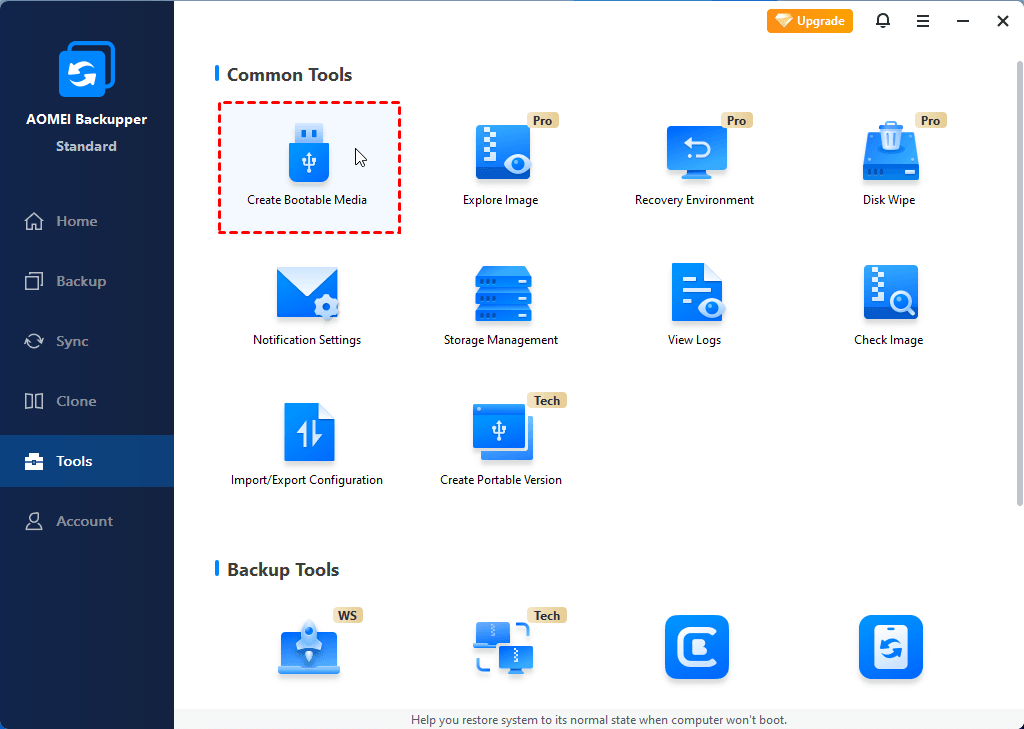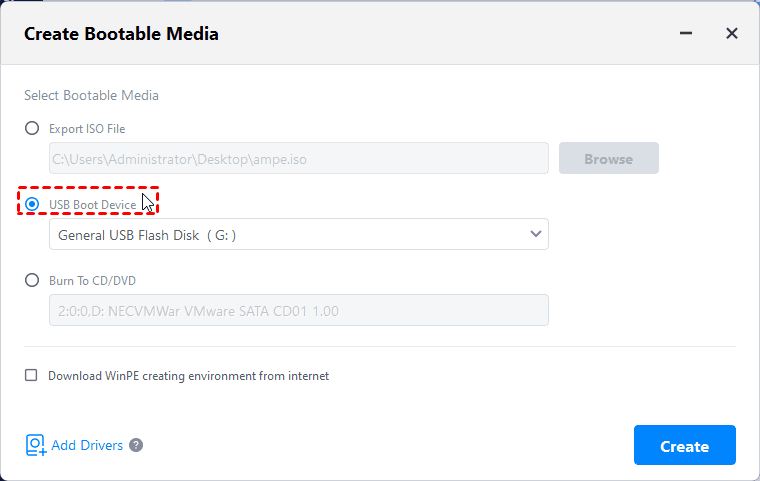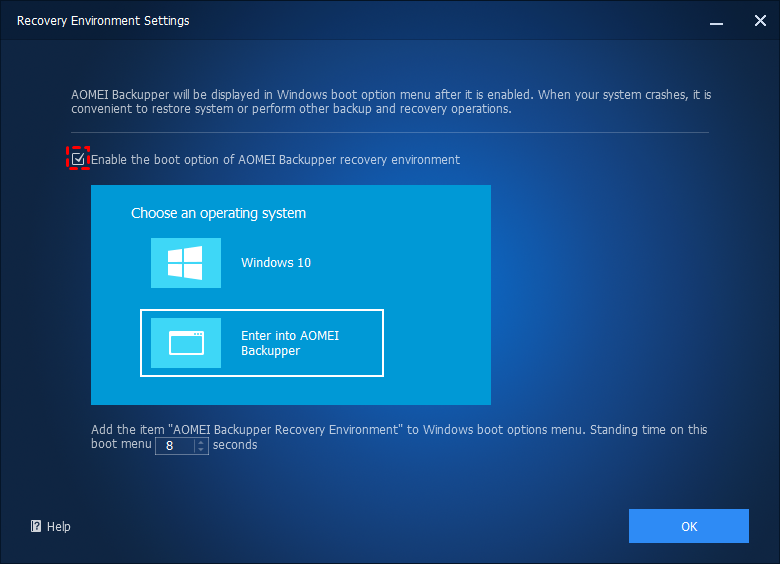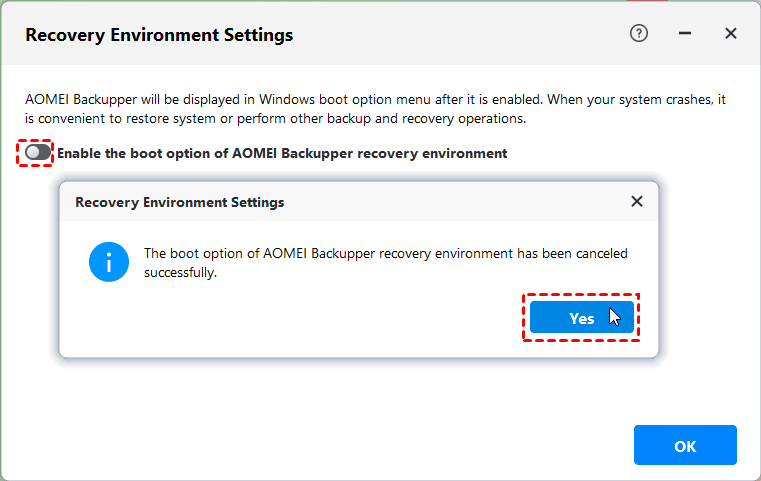How to Copy Windows 10 to USB Bootable (3 Methods)
This guide provides step-by-step instructions on how to copy Windows 10 to a USB and make it bootable, ensuring that you have a ready-to-go recovery tool in your pocket. We’ll cover multiple methods, ensuring you find the right solution for your needs.
Many users choose to use a USB to create bootable media. The main reason is that it’s lightweight and portable, making it easy to carry. Plus, it works on many devices, including ultra-thin laptops that lack optical drives. In this post, I’ll introduce 3 methods to tell how to copy Windows 10/11 to USB for free.
◉ Bootable USB: Various tools can help you create a bootable USB drive. A good example is the Create Bootable Media feature in AOMEI Backupper. This lets you boot a crashed computer into the Windows Preinstallation Environment (WinPE) to restore your system to a previous state. You can even add a boot option for system recovery without needing physical media.
◉ Installation USB: This involves copying the Windows 10 ISO file to a USB drive, and creating a bootable drive. You can use this to install or reinstall Windows 10 on the same or another computer from scratch.
◉ Recovery USB: A recovery USB contains advanced tools to troubleshoot a Windows 10 system that won’t boot. If you choose to back up system files to the USB, you can also use it to reinstall Windows 10, though it's usually tied to the specific computer it was created on.
How to copy Windows 10 from PC to pendrive (bootable)
Windows 10 comes with a Backup and Restore utility to backup files, volumes, or OS, but system files backed up in this way can only be stored as data. If you want to use the USB as a bootable drive, there are some other approaches you can take, and the results of them are functionally different.
Way 1. Easiest way to create bootable USB and repair Windows 10🔥
A bootable USB can be used for different purposes, but simply put, it can repair Windows 10 or install/reinstall Windows 10.
A simple way to fix Windows 10 is by restoring it to a previous, working state using the system backup and restore feature in AOMEI Backupper. You can also create a bootable USB or set up a boot option to recover a crashed system through WinPE—similar to Windows' System Image Recovery but much more user-friendly.
Learn more about AOMEI Backupper’s practical features below:

-
Flexible Recovery Environment: It enables you to create Windows PE boot disc for Windows 11/10/8/7.
-
Custom Storage Device: You can use USB flash drive, CD, or DVD as bootable media. You can also export AOMEI ISO file as necessary.
-
Multiple Backup Types: It allows you to backup files, partitions, systems, or entire drives as necessary.
-
Quick Backup and Restore: It enables rapid creation of backup for restoration of systems or files in a recovery environment when needed.
-
User-friendly: This operation is straightforward and easily understandable, making it accessible even for non-technical users to master and use.
✎Tips: If you don't insist on a clean install and just want to move Windows 10 installation to a new HDD or SSD, you can directly clone or image Windows 10 to a new hard drive without reinstalling. The Universal Restore feature (available in advanced editions) also allows you to restore the system to another computer with different hardware.
You can simply download the free standard edition. It already contains most of the features you need, like system backup & restore and creating bootable USB.
Preparations:
Install the software to create a system backup. You can add a schedule to auto-run it and therefore take tighter protection on Windows 10. Standard options include Daily/Weekly/Monthly, further options like specific time points and intervals are also available.
How to create Windows 10 bootable USB:
1. Navigate to the Tools tab and choose Create Bootable Media from the list.
2. Choose the media you want to copy the ISO file to. Here just choose USB Boot Device and click Create.
Thus you’ve created a bootable USB, you can rescue an unbootable computer and restore Windows 10 from USB.
If you want to perform Windows 10 recovery on the same computer:
Then you could consider adding a boot option of recovery environment using AOMEI Backupper Professional. It works just like bootable media and you don’t necessarily need a USB or CD/DVD.
1. Click Recovery Environment in Tools tab.
2. Tick Enable the boot option of AOMEI Backupper recovery environment and choose standing time of the boot option, then click Next to create recovery environment.
3. You can cancel the boot option anytime just by unchecking the option and clicking Yes.
*This recovery environment works just as bootable USB, but it can only take effect on the current PC.
Way 2. Copy Windows 10 to USB for upgrading or clean installing
Preparations:
☛ To copy Windows 10 installation to USB, you need to download MediaCreationTool first. Find “Create Windows 10 installation media” and click "Download tool now" below it.
☛ Prepare a USB flash drive with at least 8 GB. If it’s not empty, the data stored in it will be erased, then it’s better to make a backup in advance.
☛ You’ll need your 25-character product key to activate Windows.
How to copy Windows setup to the USB flash drive:
1. Open the MediaCreationTool. If you want to upgrade or reinstall the current computer right away, just choose Upgrade this PC now, otherwise please choose Create installation media for another PC and click Next.
2. Select the configurations of the Windows 10 ISO you will download. If you want to use the USB on the same computer, just let it Use the recommended options for this PC, otherwise please uncheck it to make your choices according to actual situation.
If you are not sure what’s your architecture (32-bit or 64-bit), check it in Control Panel > System > System type.
3. Choose USB flash drive and click Next to copy Windows 10 ISO to USB. You can then use it to boot and (re)install the same or another computer.
To install Windows 10 from USB, just connect it to the computer with corresponding configurations, enter BIOS to set the USB as the first place in boot order, then choose language and keyboard layout. You will be required to enter the product key, you can register it now or later. Then, just follow the wizard to clean install Windows 10.
Way 3. Copy Windows 10 to USB for troubleshooting or reinstallation
Preparations:
☛ You need a USB drive with at least 16 gigabytes space to create a recovery drive.
☛ The USB better be empty, otherwise the data in it will be erased. Sure, you can also backup files on USB at first.
☛ Connect the USB to your computer.
How to copy Windows 10 to USB and make it bootable:
1. Search “recovery drive” on the taskbar to run the tool. Tick the option Backup system files to the recovery drive, otherwise the USB cannot be used to reinstall Windows 10. Click Next to continue.
2. Wait till your USB is detected. Select it and hit Next.
3. Start to Create the recovery drive. When it's complete, eject the USB.
*If you fail to create recovery USB, read this post about can’t backup system to USB drive.
When the computer breaks down, just insert the USB > restart the PC and press the required key to enter BIOS > set the bootable USB as the first boot option > save settings and exit > choose keyboard layout > choose Troubleshoot.
Then, you can either select Advanced options to troubleshoot Windows 10 with Startup Repair, System Restore, System Image Recovery, Safe Mode, Command Line, etc., or select Recover from a USB to reinstall Windows and decide whether to remove personal files or fully clean the drive.
Bonus: Benefits of creating Windows 10 bootable USB
As technology evolves and Windows continues to update, you won’t stick with the same operating system on the same device forever. This creates a need for portable bootable media, like a USB drive. For example, you might want to copy Windows 10 to a USB drive and use it for:
- Installing a clean version of Windows 10 on new hardware.
- Upgrading from an older version, like Windows 7, to Windows 10.
- Booting a crashed computer to access the Windows 10 recovery environment for troubleshooting.
FAQs on Copying Windows 10 to USB Bootable Drive
1. What is a bootable USB drive and why do I need it for Windows 10?
A bootable USB drive is a portable storage device that contains an operating system, such as Windows 10, which allows you to boot your computer from the USB drive rather than the internal hard drive. This is useful for tasks like installing or repairing Windows 10 without accessing the computer's internal storage.
2. What are the minimum requirements for the USB drive to copy Windows 10?
To create a bootable USB drive for Windows 10, you'll need a USB flash drive with a capacity of at least 8 GB. Ensure that the USB drive is formatted properly and has no important data on it, as the process will erase all existing data on the drive.
3. Can I use a USB drive with existing data on it to copy Windows 10?
No, it's not recommended to use a USB drive with existing data on it for creating a bootable Windows 10 drive. The process of copying Windows 10 to the USB drive will erase all existing data on the drive, so it's best to use a blank USB drive or one that you don't mind formatting.
4. What should I do after copying Windows 10 to the USB drive?
After successfully copying Windows 10 to the USB drive, you can use it to boot your computer and perform tasks such as installing Windows 10 on a new computer or repairing an existing installation. Remember to change the boot order in your computer's BIOS settings to prioritize booting from the USB drive to initiate the Windows 10 installation process.
5. How do I boot from the USB drive after creating it?
Insert the bootable USB drive into your computer, restart, and enter the BIOS or UEFI settings (usually by pressing F2 or Del during startup). Change the boot order to prioritize the USB drive.
Tips for Creating a Bootable USB Drive
-
Always Use USB 3.0: For faster data transfers and smoother installation, using a USB 3.0 drive is recommended, especially for large installations like Windows 10.
-
Verify the ISO File: Always download the ISO file from a trusted source like Microsoft’s official website to avoid corrupted or incomplete installations.
-
Use Multiple Tools: If one method doesn’t work or if the bootable USB is not recognized, try a different tool like Rufus or AOMEI Backupper to ensure compatibility with your system.
Conclusion
You can create a bootable USB for Windows 10 using either the Media Creation Tool or the Recovery Drive utility. However, for more reliable system protection and an easier process, AOMEI Backupper is a great option. It allows you to automatically back up your system and use a bootable USB to restore your computer whenever needed.
If you’re looking to move Windows 10 to a new drive without reinstalling, AOMEI Backupper also supports OS migration, such as transferring Windows from HDD to SSD.





